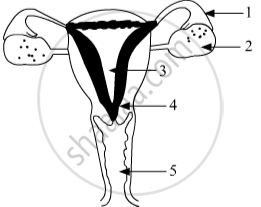Advertisements
Advertisements
प्रश्न
Explain the process of fertilization in human beings.
उत्तर
Fertilisation:
- Fertilisation takes place when the sperm unites with the egg.
- The sperms enter through the vaginal passage and travel upwards and reach the oviduct.
- In the oviduct, one of the sperms fuses with the egg and the fertilisation is completed.
APPEARS IN
संबंधित प्रश्न
Explain the process of birth in human beings.
What are the functions of testes in the human male reproductive system?
If a woman is using a copper-T, will it help in protecting her from sexually transmitted diseases?
What are the different methods of contraception?
What could be the reasons for adopting contraceptive methods?
State the main function of the Leydig cells
Differentiate between Sperm duct and fallopian rube (function)
State the main function of the Sperm duct.
Given below are diagrams showing the different stages in the process of fertilisation of an egg. in the human female reproductive tract.
Study the diagrams and answer the questions:
1) Arrange the letters given below each diagram in a logical sequence to show the correct order in the process of fertilisation.
2) Where does fertilisation normally take place? and What is ‘Implantation’ that follows fertilisation?
3) Mention the chromosome number of the egg and zygote in humans.
4) Explain the term ‘Gestation’. How long does Gestation last in humans?
5) Draw a neat, labelled diagram of a mature human sperm.
State whether human beings reproduce by sexual method or asexual method.
Where is the female gamete formed in humans?
Do all organisms give birth to individuals like humans?
Which part of the human body passes sperms from a man to a woman?
What do the testes in a man produce?
Name the liquid that contains sperms.
One of the following is not a part of the human male reproductive system. This is
(a) testis
(b) oviduct
(c) seminal vesicle
(d) prostrate gland
Which of the following is not a sexually transmitted disease?
(a) gonorrhoea
(b) hepatitis
(c) syphilis
(d) AIDS
In human females, an event that indicates the onset of reproductive phase is :
(a) growth of body
(b) change in hair pattern
(c) change in voice
(d) menstruation
When a fertilised egg E formed in the oviduct of a human female divides repeatedly to form an embryo, the embryo gets implanted in the thick and soft lining of the uterus. After this a disc-like special tissue T develops between the uterus wall and embryo through which all the requirements of the developing embryo (and foetus) are met from the mother's body, The embryo is connected to the tissue T through a string like structure S.
(a) What is the other name of fertilised egg cell E?
(b) What is the name of tissue T?
(c) Name the string-like structure S.
(d) Name two substances which pass from mother's blood to embryo through tissue T and, one type of substance which passes from embryo to mother's blood.
(e) What happens to S when the baby is born? Why?
The normal gestation period in humans is:
Trace the path of sperms from where they are produced in human body to the exterior.
State the role of placenta in the development of embryo.
Fill in the blank.
In humans, sperm production occurs in the organ ----------------.
In male and female reproductive system of human, ______ gland is same.
Fill in the blank.
Pollen grains are formed by ______ division in locules of anthers.
Sketch and label human female reproductive system.
Is the woman responsible for sex-determination of child? Justify your answer.
Give appropriate term of the following:
The onset of reproductive phase in a young female.
Choose the correct answer:
The aim of sexual reproduction _________
Draw a diagram to display the vertical view of human female reproductive system and label the following parts in the diagram:
(1) Ureter
(2) Ovary
(3) Funnel of fallopian tube
(4) Urethra.
Identify the given diagram.
Name the parts 1 to 5. 
Differentiate on the basis of what is indicated in brackets :
The prostate gland and Cowper’s gland (the nature of secretion)
Give Reasons
At the time of birth, the testes descend into the scrotal sacs.
Differentiate
Urinogenital system and Urinary system.
Draw a labeled diagram of the human female reproductive system.
Mention the importance of the position of the testes in humans.
The membranous cover of the ovum at ovulation is ______.
How does human sperm locomote?
Freshly released human egg has ______.
Distinguish between Vasa efferentia and Vasa deferentia.
